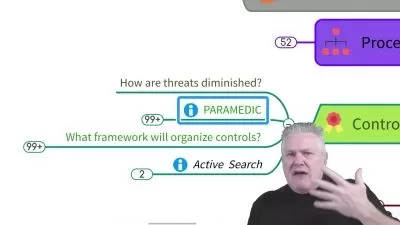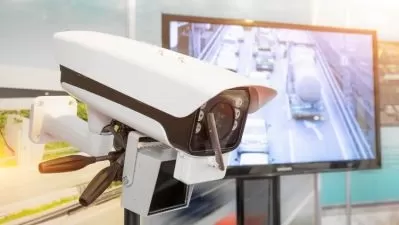Comptia Security Plus | Comptia Security+ (SY0-601) Prep Lab
Muharrem AYDIN,OAK Academy Team
25:36:32
Description
Comptia Security Plus | Prepare for Comptia Security+ Certification with me& pursue a cybersecurity or IT security roles
What You'll Learn?
- Every internet-connected person is affected by issues pertaining to cybersecurity. As a result, cybersecurity professionals are increasingly in-demand.
- Security+ opens the door to your cybersecurity career!
- Oak Academy offers top-rated CompTIA Security+ exam prep courses to help you prepare for the job market.
- CompTIA Security+ is a global certification that validates the baseline skills necessary to perform core security functions and pursue an IT security career.
- CompTIA Security+ is the first security certification a candidate should earn. It establishes the core knowledge required of any cybersecurity role.
- What is CompTIA Security+ exam?
- Why is the CompTIA Security + course important?
- All information on CompTIA Security + exam topics.
- What are Attacks, Threats and Vulnerabilities in comtia?
- What should the architecture and design covered under CompTIA Security + be?
- What are network topologies and network attacks?
- What is threat, what are threat types, how is threat analysis done?
- What are Social Engineering Attacks?
- What is a database, how is Database Security provided?
- What is Cryptography and PKI? What type of Cryptography is used?
- comptia security
- CompTIA Security+(SYO-601)
- comptia server
- comptia security plus
- CompTIA Security+certification
- comptia sec+
- comptia
- CompTIA Security+(SYo-601)
Who is this for?
More details
DescriptionHello there,
Welcome to the “Comptia Security Plus | Comptia Security+ (SY0-601) Prep Lab†course.
Comptia Security Plus | Prepare for Comptia Security+ Certification with me& pursue a cybersecurity or IT security roles
CompTIA Security+ is a global certification that validates the baseline skills necessary to perform core security functions and pursue an IT security career.
CompTIA Security+ opens the door to your cybersecurity career!
Every internet-connected person is affected by issues pertaining to cybersecurity. As a result, cybersecurity professionals are increasingly in-demand. That’s why Oak Academy offers top-rated CompTIA Security+ exam prep courses to help you prepare for the job market. Comptia security plus, Comptia Security+, cybersecurity, Comptia Security+ Certification, security, Comptia Security+ (SY0-601).
CompTIA Security+ is the first security certification a candidate should earn. It establishes the core knowledge required of any cybersecurity role and provides a springboard to intermediate-level cybersecurity jobs. Security+ incorporates best practices in hands-on troubleshooting, ensuring candidates have practical security problem-solving skills required to:
Assess the security posture of an enterprise environment and recommend and implement appropriate security solutions
Monitor and secure hybrid environments, including cloud, mobile, and IoT
Operate with an awareness of applicable laws and policies, including principles of governance, risk, and compliance
Identify, analyze, and respond to security events and incidents
Cybersecurity attacks continue to grow. Increasingly, more job roles are tasked with baseline security readiness and response to address today’s threats. Updates to Security+ reflect skills relevant to these job roles and prepare candidates to be more proactive in preventing the next attack. To combat these emerging threats, IT Pros must be able to:
Help identify attacks and vulnerabilities to mitigate them before they infiltrate IS
Understand secure virtualization, secure application deployment, and automation concepts
Identify and implement the best protocols and encryption
Understand the importance of compliance
This course walks you through all the things you need to pass the CompTIA Security + (SY601) exam, step by step.
You can pass the CompTIA Security + exam by studying the topics covered throughout the course.
By the way, you don't need to know anything about CompTIA security +.
We will tell you all the things you need to pass the comtia security plus (SY601) exam.
In order to better understand the topics, these basic topics are divided into parts and explained in chapters in CompTIA Security+(SYo-601).
Each of the sections is important on its own. It also relates to other departments.
As you follow the course, you will hear the same terms in different lessons. This is because many terms in the field of Security can be used in relation to each other in different subjects.
For example, the subject of encryption is mentioned in many places.
Although the basic meaning is the same, usage types can gain different meanings on different platforms.
The narration of the topics is brief and for the exam.
If you wish, you can improve yourself by using the topics covered in the lessons.
Because at the end of the course, you will see all the topics used in the field of Security.
All you have to do is search the subject on the internet and continue learning in comptia security.
During the course, sample questions were given at the end of each section in comptia.
These questions are generally similar to questions that were previously found in the CompTIA Security + exam.
There is no such thing as the same question will always appear in the exam in CompTIA.
However, the questions to be asked on a certain subject are also close to each other in comtia.
This course is for Comptia Security + (SY0-601).
CompTIA updates its exams every 3 years.
SY0-601 exam has been updated in 2020.
CompTIA Security+(SYO-601)
Basically in CompTIA Security + (SY0-601) exam;
1. Attacks, Threats, and Vulnerabilities
2. Architecture and Design
3. Implementation
4. Operations and Incident Response
5. Governance, Risk, and Compliance
Questions are asked from the fields. Throughout the course, topics related to these areas are explained.
In this course you will learn;
Passing the CompTIA Security+ certification exam with confidence
Understand computer security, its functions, and its components
Performing basic security configurations
Become an effective security technician in a business environment
Network topologies
Threat analysis
Frequently asked questions
Is the CompTIA Security+ worth it?
Certifications tell hiring managers that potential hires have the necessary skills to perform specific tasks and can save time spent on training. Specifically speaking, the CompTIA Security+ says that a candidate understands basic cybersecurity concepts and can perform cybersecurity tasks. When you are new to the field, this certificate proves you have this knowledge when you have little experience. The CompTIA Security+ certification ranks high on Global Knowledge's list of top-paying certifications because it is a vendor-neutral certification that will help you get many well-paying, entry-level jobs. Once you have a few years of experience working in IT security, it will count for more than the certification.
What are the skills evaluated in Security+?
The CompTIA Security+ exam (SY0-501) tests that the applicant has a basic knowledge to perform IT security tasks and work in the cybersecurity field. Applicants will demonstrate their ability to assess the security of an enterprise environment, find security flaws, and implement solutions to improve security. They will also need to know how to monitor and secure cloud, mobile, and IoT environments. The exam will test knowledge of the principles of governance, risk, and compliance and the ability to follow those principles. Applicants that pass the CompTIA Security+ certification will also be able to identify, track, and respond to a security-related incident in the enterprise IT environment. The CompTIA Security+ is an entry-level certification and is the first certification an IT security candidate should earn.
What types of places hire people with a Security+ certification?
Just about any business that requires IT staff to manage the software, applications, and infrastructure necessary to keep the business running are looking for security professionals that have a CompTIA Security+ certification. Because this certification meets the Department of Defense standards for security professionals, a Security+ professional can find a job working for a government agency, for laboratories that do work for the government, and for other companies that have government contracts. Other businesses looking for penetration testers, systems administrators, network administrators, and security administrators that are Security+ certified include major tech companies, state universities, healthcare companies, and insurance companies.
What skills or experience do I need before pursuing the CompTIA Security+ certification?
The CompTIA Security+ certification is an entry-level certification for information technology security professionals, so it is the first certificate a candidate on the CompTIA+ cybersecurity career path should take. Although this is an entry-level certificate, there are some things you should know to ensure you can succeed at taking the Security+ exam. You should have a fundamental knowledge of computer and networking concepts. It will also help if you already have the CompTIA A+ and Network+ certifications or equivalent knowledge. You should have some on-the-job experience in the IT field as well. It is recommended that you have six to nine months of networking experience and two years of IT administration experience before you take the exam.
What domains are covered in the CompTIA Security+ exam?
The CompTIA Security+ exam is a vendor-neutral exam that tests applicants' knowledge of IT security and their ability to perform core security functions. Around 20% of the questions will cover the topics of threats, vulnerabilities, and attacks. Applicants will have to understand various types of compromise and understand penetration testing and vulnerability scanning. An equal portion of the test will cover the technologies and tools a security professional will use to accomplish security tasks. Next, about 16% of the test will be questions that test a candidate’s knowledge of identity and access management. Around 15% of the exam will cover secure network concepts, architecture, and design. The remaining portion of the exam will validate an applicant's knowledge of risk management best practices, cryptography, and Public Key Infrastructure (PKI).
What are some careers that use CompTIA Security+?
The CompTIA Security+ certification is the industry standard for testing the minimum skills that an IT security professional needs on the job. This certificate complies with ISO 17024 standards and meets the directive 8140/8570.01-M requirements of the Department of Defense. This certification covers the role of junior IT auditor/penetration tester. Another job title an applicant with a Security+ might pursue is system administrator, whose responsibilities include maintaining user accounts and access, which requires a knowledge of enterprise security. Network administrator and security administrator jobs may also require that applicants have CompTIA Security+ certification. Of course, any hiring manager looking to fill positions that involve IT security, like security specialist, security consultant, or security engineer, would most likely consider Security+ certification a bonus.
No prior knowledge is needed!
Why would you want to take this course?
Our answer is simple: The quality of teaching.
Video and Audio Production Quality
All our videos are created/produced as high-quality video and audio to provide you the best learning experience.
You will be,
Seeing clearly
Hearing clearly
Moving through the course without distractions
You'll also get:
Lifetime Access to The Course
Fast & Friendly Support in the Q&A section
Udemy Certificate of Completion Ready for Download
Dive in now into “Comptia Security Plus | Comptia Security+ (SY0-601) Prep Lab†course.
Comptia Security Plus | Prepare for Comptia Security+ Certification with me& pursue a cybersecurity or IT security roles
We offer full support, answering any questions.
See you in the course!
Who this course is for:
- Those who want to get CompTIA Security + certificate
- Anyone interested in cyber security and want a job career in IT security
- Those who have a career goal in the field of cybersecurity
- Those who have a basic knowledge of security and want to take it to higher levels
- Those who want to step into the world of cybersecurity
- Those whose Jobs (like Security Administrator, Systems Administrator, Security Engineer / Analyst) that use CompTIA Security+ and want to improve themselves
- Junior Security elements
Hello there,
Welcome to the “Comptia Security Plus | Comptia Security+ (SY0-601) Prep Lab†course.
Comptia Security Plus | Prepare for Comptia Security+ Certification with me& pursue a cybersecurity or IT security roles
CompTIA Security+ is a global certification that validates the baseline skills necessary to perform core security functions and pursue an IT security career.
CompTIA Security+ opens the door to your cybersecurity career!
Every internet-connected person is affected by issues pertaining to cybersecurity. As a result, cybersecurity professionals are increasingly in-demand. That’s why Oak Academy offers top-rated CompTIA Security+ exam prep courses to help you prepare for the job market. Comptia security plus, Comptia Security+, cybersecurity, Comptia Security+ Certification, security, Comptia Security+ (SY0-601).
CompTIA Security+ is the first security certification a candidate should earn. It establishes the core knowledge required of any cybersecurity role and provides a springboard to intermediate-level cybersecurity jobs. Security+ incorporates best practices in hands-on troubleshooting, ensuring candidates have practical security problem-solving skills required to:
Assess the security posture of an enterprise environment and recommend and implement appropriate security solutions
Monitor and secure hybrid environments, including cloud, mobile, and IoT
Operate with an awareness of applicable laws and policies, including principles of governance, risk, and compliance
Identify, analyze, and respond to security events and incidents
Cybersecurity attacks continue to grow. Increasingly, more job roles are tasked with baseline security readiness and response to address today’s threats. Updates to Security+ reflect skills relevant to these job roles and prepare candidates to be more proactive in preventing the next attack. To combat these emerging threats, IT Pros must be able to:
Help identify attacks and vulnerabilities to mitigate them before they infiltrate IS
Understand secure virtualization, secure application deployment, and automation concepts
Identify and implement the best protocols and encryption
Understand the importance of compliance
This course walks you through all the things you need to pass the CompTIA Security + (SY601) exam, step by step.
You can pass the CompTIA Security + exam by studying the topics covered throughout the course.
By the way, you don't need to know anything about CompTIA security +.
We will tell you all the things you need to pass the comtia security plus (SY601) exam.
In order to better understand the topics, these basic topics are divided into parts and explained in chapters in CompTIA Security+(SYo-601).
Each of the sections is important on its own. It also relates to other departments.
As you follow the course, you will hear the same terms in different lessons. This is because many terms in the field of Security can be used in relation to each other in different subjects.
For example, the subject of encryption is mentioned in many places.
Although the basic meaning is the same, usage types can gain different meanings on different platforms.
The narration of the topics is brief and for the exam.
If you wish, you can improve yourself by using the topics covered in the lessons.
Because at the end of the course, you will see all the topics used in the field of Security.
All you have to do is search the subject on the internet and continue learning in comptia security.
During the course, sample questions were given at the end of each section in comptia.
These questions are generally similar to questions that were previously found in the CompTIA Security + exam.
There is no such thing as the same question will always appear in the exam in CompTIA.
However, the questions to be asked on a certain subject are also close to each other in comtia.
This course is for Comptia Security + (SY0-601).
CompTIA updates its exams every 3 years.
SY0-601 exam has been updated in 2020.
CompTIA Security+(SYO-601)
Basically in CompTIA Security + (SY0-601) exam;
1. Attacks, Threats, and Vulnerabilities
2. Architecture and Design
3. Implementation
4. Operations and Incident Response
5. Governance, Risk, and Compliance
Questions are asked from the fields. Throughout the course, topics related to these areas are explained.
In this course you will learn;
Passing the CompTIA Security+ certification exam with confidence
Understand computer security, its functions, and its components
Performing basic security configurations
Become an effective security technician in a business environment
Network topologies
Threat analysis
Frequently asked questions
Is the CompTIA Security+ worth it?
Certifications tell hiring managers that potential hires have the necessary skills to perform specific tasks and can save time spent on training. Specifically speaking, the CompTIA Security+ says that a candidate understands basic cybersecurity concepts and can perform cybersecurity tasks. When you are new to the field, this certificate proves you have this knowledge when you have little experience. The CompTIA Security+ certification ranks high on Global Knowledge's list of top-paying certifications because it is a vendor-neutral certification that will help you get many well-paying, entry-level jobs. Once you have a few years of experience working in IT security, it will count for more than the certification.
What are the skills evaluated in Security+?
The CompTIA Security+ exam (SY0-501) tests that the applicant has a basic knowledge to perform IT security tasks and work in the cybersecurity field. Applicants will demonstrate their ability to assess the security of an enterprise environment, find security flaws, and implement solutions to improve security. They will also need to know how to monitor and secure cloud, mobile, and IoT environments. The exam will test knowledge of the principles of governance, risk, and compliance and the ability to follow those principles. Applicants that pass the CompTIA Security+ certification will also be able to identify, track, and respond to a security-related incident in the enterprise IT environment. The CompTIA Security+ is an entry-level certification and is the first certification an IT security candidate should earn.
What types of places hire people with a Security+ certification?
Just about any business that requires IT staff to manage the software, applications, and infrastructure necessary to keep the business running are looking for security professionals that have a CompTIA Security+ certification. Because this certification meets the Department of Defense standards for security professionals, a Security+ professional can find a job working for a government agency, for laboratories that do work for the government, and for other companies that have government contracts. Other businesses looking for penetration testers, systems administrators, network administrators, and security administrators that are Security+ certified include major tech companies, state universities, healthcare companies, and insurance companies.
What skills or experience do I need before pursuing the CompTIA Security+ certification?
The CompTIA Security+ certification is an entry-level certification for information technology security professionals, so it is the first certificate a candidate on the CompTIA+ cybersecurity career path should take. Although this is an entry-level certificate, there are some things you should know to ensure you can succeed at taking the Security+ exam. You should have a fundamental knowledge of computer and networking concepts. It will also help if you already have the CompTIA A+ and Network+ certifications or equivalent knowledge. You should have some on-the-job experience in the IT field as well. It is recommended that you have six to nine months of networking experience and two years of IT administration experience before you take the exam.
What domains are covered in the CompTIA Security+ exam?
The CompTIA Security+ exam is a vendor-neutral exam that tests applicants' knowledge of IT security and their ability to perform core security functions. Around 20% of the questions will cover the topics of threats, vulnerabilities, and attacks. Applicants will have to understand various types of compromise and understand penetration testing and vulnerability scanning. An equal portion of the test will cover the technologies and tools a security professional will use to accomplish security tasks. Next, about 16% of the test will be questions that test a candidate’s knowledge of identity and access management. Around 15% of the exam will cover secure network concepts, architecture, and design. The remaining portion of the exam will validate an applicant's knowledge of risk management best practices, cryptography, and Public Key Infrastructure (PKI).
What are some careers that use CompTIA Security+?
The CompTIA Security+ certification is the industry standard for testing the minimum skills that an IT security professional needs on the job. This certificate complies with ISO 17024 standards and meets the directive 8140/8570.01-M requirements of the Department of Defense. This certification covers the role of junior IT auditor/penetration tester. Another job title an applicant with a Security+ might pursue is system administrator, whose responsibilities include maintaining user accounts and access, which requires a knowledge of enterprise security. Network administrator and security administrator jobs may also require that applicants have CompTIA Security+ certification. Of course, any hiring manager looking to fill positions that involve IT security, like security specialist, security consultant, or security engineer, would most likely consider Security+ certification a bonus.
No prior knowledge is needed!
Why would you want to take this course?
Our answer is simple: The quality of teaching.
Video and Audio Production Quality
All our videos are created/produced as high-quality video and audio to provide you the best learning experience.
You will be,
Seeing clearly
Hearing clearly
Moving through the course without distractions
You'll also get:
Lifetime Access to The Course
Fast & Friendly Support in the Q&A section
Udemy Certificate of Completion Ready for Download
Dive in now into “Comptia Security Plus | Comptia Security+ (SY0-601) Prep Lab†course.
Comptia Security Plus | Prepare for Comptia Security+ Certification with me& pursue a cybersecurity or IT security roles
We offer full support, answering any questions.
See you in the course!
Who this course is for:
- Those who want to get CompTIA Security + certificate
- Anyone interested in cyber security and want a job career in IT security
- Those who have a career goal in the field of cybersecurity
- Those who have a basic knowledge of security and want to take it to higher levels
- Those who want to step into the world of cybersecurity
- Those whose Jobs (like Security Administrator, Systems Administrator, Security Engineer / Analyst) that use CompTIA Security+ and want to improve themselves
- Junior Security elements
User Reviews
Rating
Muharrem AYDIN
Instructor's CoursesOAK Academy Team
Instructor's Courses
Udemy
View courses Udemy- language english
- Training sessions 318
- duration 25:36:32
- Release Date 2023/04/26















